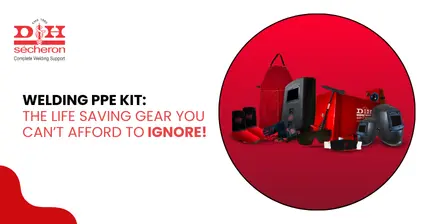We are all aware of welding, as an overarching concept. Some of us might still be figuring out different kinds of welding. Gas welding is one of these commonly used types of welding. Let’s start this blog article with the very explanation of Gas Welding.
Gas welding is the process of joining two metals using heat generated by the flames. The transmission of this heat thus melts the two and joins them ultimately, to act as one piece after the welding is done. To get this done, the welder requires welding material that creates high-temperature flames. Oxygen mixed with gases like propylene, butane and hydrogen are the kinds of flammable gases used.
The electrode most commonly used to join the two metals is tungsten. Therefore, this type of welding is also called gas tungsten arc welding or TIG. Other names for the same are, gas metal arc welding or GMAW welding.
It is one of the original forms of heat-based welding and is applicable to a wide variety of fields since it is easier to maneuver and master as well as it costs less than most types of welding.
Application of gas welding
Repairing existing machinery, tools, equipment and other things made of metal is one of the most obvious uses of GMAW welding.
Medium and thin sheets of metals are welded with ease using gas welding materials.
It is also used in the locomotive industries, including automobile and aircraft industries respectively.
Advantages of gas welding
Gas welding does not require electricity to operate, unlike most forms of welding. The gas welding material is sustaining without electricity, as opposed to arc welding. This makes it usable in areas that do not have electricity, making it a saviour for all!
This doesn’t require any heavy-duty or specialised machinery and therefore costs less than most forms of welding as well.
Beginners can master gas welding rather quickly, making it one of the simplest types of welding and easy to access for welders and workers who haven’t specialised. This opens doors and opportunities for all, and increases the likelihood of employment as well.
One wild and crazy advantage of gas welding is that it can weld ferrous metals with non-ferrous metals as well! I know, crazy right?
Disadvantages of gas welding
While gas welding is apt for thinner sheets, it isn’t cut out for thicker sections of a machine, chair, automobile, or whatever it is that one is working on.
The rate of heating is quite slow which makes it slower as an entire process. It is easier than other types of welding, but also requires more patience.
It does not reach the same temperatures as that of arc welding. Therefore, it isn’t the ideal type of welding for high-strength steels.
It is missing a dedicated flux shielding system, thus it might not meet someone’s requirement if that is what they are looking for.
Now that you know all about gas welding: its applications, advantages as well as disadvantages, we hope it helps you make a well-informed decision as to which type of welding will match and fit your needs and requirements.
11 May 2025 | Welding
An In-Depth Exploration of Low-Alloy Steel: Your Comprehensive Guide
11 May 2025 | Welding
Nagpur - Bori - Tuljapur Road MSH-3 in Yavatmal District (Maharashtra)
11 May 2025 | Welding
3 Tips for Finding the Best Mild Steel Electrode for Your Application
11 May 2025 | Welding
How to Select the Right Welding Filler Wires for Stainless Steel Welding?
11 May 2025 | Welding
Building the Narendra Modi Stadium with Norma V and Autotherme-1 Electrodes
11 May 2025 | Welding
Low Alloy Steel Welding in a (PEB) Pre Engineered Building Structure
11 May 2025 | Welding
Welding Rods: Different Types and Tips for Properly Storing and Handling
11 May 2025 | Welding
Tips for Flawless Welds with Stainless Steel Electrodes: Pros and Cons
11 May 2025 | Welding
Exploring Applications and Benefits of Stainless Steel Welding Electrodes
11 May 2025 | Welding
Welding Basics: Joining Metals with Heat and Pressure - A Beginners Guide
11 May 2025 | Welding
Distinguishing Low-Alloy Steel from High-Alloy Steel: Understanding the Variations
11 May 2025 | Welding
Hard Facing Wire - Understanding the Process and Achieving Optimal Result
11 May 2025 | Welding
Exploring the Advantages of Stainless Steel Electrodes in Welding Applications
11 May 2025 | Welding
Weathering Steel vs. Traditional Steel: A Comparative Analysis of Performance
11 May 2025 | Welding
Choosing the Right Welding Rod: Why 6013 Electrodes Might Be Your Ideal Option
11 May 2025 | Welding
Why 7018 Electrodes Are Preferred for High-Strength Welds in Pipeline Construction
11 May 2025 | Welding
Filler Wire vs. Stainless Steel Filler Wire: Understanding the Key Differences
11 May 2025 | Welding
Exploring the Impact of Filler Material on Welding Quality and Durability
11 May 2025 | Welding
Choosing the Right Cast Iron Electrode for Different Welding Projects
11 May 2025 | Welding
Top Advantages of Cast Iron Electrodes for Industrial Welding Applications
11 May 2025 | Welding
Key Benefits and Challenges of Using TIG Welding in Industrial Projects
11 May 2025 | Welding
5 Reasons Why 7018 Electrode is the Gold Standard for Welding Professionals
11 May 2025 | Welding
Top 5 Advantages of Flux Cored Arc Welding for Heavy-Duty Applications.png)
11 May 2025 | Welding
Lotherme-601: A Game-Changer for Restoring Shoulder Pins in Heavy Machinery
11 May 2025 | Welding
How D&H Sécheron Helped Repair a Rotary Kiln’s Cooler Section with LoTherme 352
11 May 2025 | Welding
Piston Repair for Mining Industry: Cost-Effective Solutions with LoTherme 468.webp)






.jpg)








































.jpg)
.jpg)

.jpg)

.jpg)





.jpg)
.jpg)
.jpg)



.webp)
.jpg)
.jpg)
.webp)
.jpg)






















.png)



.webp)

.webp)
.webp)



